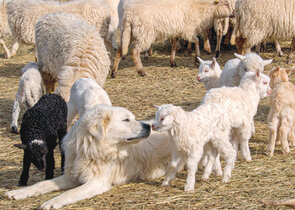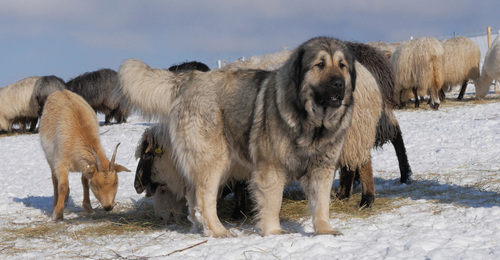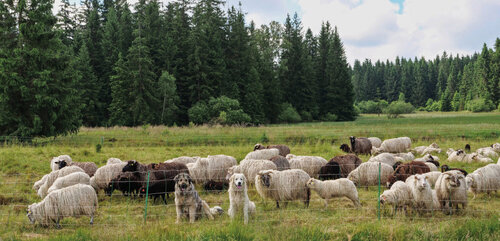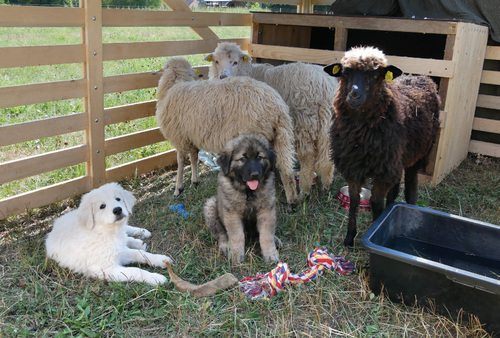Nature Conservation 2022 — 25. 5. 2022 — Nature and Landscape Management — Print article in pdf
Experience in Training Shepherd Dogs Guarding Livestock

Shepherd dogs guarding livestock are rightly recommended as the most effective measure against grey wolves (Canis lupus) attacking livestock. Farmers are often criticized for hesitating to acquire shepherd dogs. However, few people can imagine the long and challenging journey to a reliable working shepherd dog.
Wolves are near
Among its other activities, our organization, Libosváry, a Local Chapter of the Czech Union for Nature Conservation, has been maintaining a number of biologically valuable sites in the Domažlice and Tachov regions in western Bohemia by grazing sheep, goats, and yaks for over 20 years. Thus, we had watched the rapid spread of grey wolves in neighbouring Germany with growing concern. In 2018, their permanent occurrence of the canid predators was confirmed in our areas of activity. We did not want our animals to appear on the wolf’s diet.
If we used free grazing under the constant supervision of a shepherd, we would use our rich experience with cattle dogs. Unlike shepherd dogs, they are easily-manageable, they can actively manipulate a herd on human command and, at the same time, they are very good and brave guardians (e.g. the Beauceron, Briard or Bouvier breeds).
For organizational and economic reasons, we graze within electric fences without the presence of a shepherd, only with regular daily inspections. Therefore, shepherd dogs working independently are the only suitable solution for us to maximize the effectiveness of preventive “anti-wolf” measures.

A shepherd dog guards the herd all year round in any weather. © František Groessl
Selecting dogs
The task of the shepherd dogs is only to accompany and guard the herd, not to manipulate it! You cannot buy a reliable shepherd dog; you must educate it and be prepared for the fact that it is 100% usable only after reaching the age of two to three. In addition, there is a relatively high risk (up to 50%) that the dog lacks the required talent or that its upbringing will fail.
Three years ago, there was no real breeding of working shepherd dogs in the Czech Republic. There were only breeders who bought a few sheep or goats to go with the dogs. Therefore, they were still more or less family dogs who, at best, had met with considerably domesticated and appropriately cheeky sheep and goats in the backyard. We certainly cannot talk about independent work of shepherd dogs there, least of all guarding from wolves.
We were deciding whether to buy one dog or two. One puppy will stick to the sheep more easily because it will have no other chance. However, there is a higher risk that it will play with sheep and chase them more often because it will be bored. In the case of two puppies, there is a risk that they will not develop a strong enough relationship with the guarded animals because it will be enough for them to have each other. However, they can play together and not disturb the sheep unnecessarily. Puppies born in a herd have a better starting position. They will not experience a “culture shock” as they do not have to cope with a radical change of conditions – minimal contact with humans and a number of, from their point of view, strangely behaving animals. However, the subsequent upbringing is exactly the same as for puppies from regular breeding.
We also had to decide on the size of the breed; we did not want large dogs that could look over our 90-cm-high electrical fences and scare passers-by. We also considered the length of the coat; the shorter it is, the easier it is to care for it. On the other hand, we have animals outside all year round and we graze in areas with a high incidence of stinging insects, where longer hair is an advantage.
By far the most available breeds for us were the Slovak Cuvac and the Sharplaninac. We chose the Cuvac with the knowledge that they have no longer been working dogs, but social dogs. Puppies born in a herd of sheep were not availa- ble, so we bought two puppies of the same age from regular breeding.
Difficult beginnings
The advice on how to raise a shepherd dog is very diverse: from “raise a puppy in the family and take it on a lead to the sheep several times a day” to “throw a puppy in a sheep hut and do not pay attention to it, except for feeding.” Because we need independent shepherd dogs, it is by far the most difficult to solve the problem of how to raise such a dog when you can spend only a minimum of time with it. Otherwise, the puppy would prefer human society to the animals it is supposed to protect in the future.
We have carefully studied all available publications on shepherd dog training. We chose a procedure that seemed logical to us. We placed the puppies in a pen with several curious lambs. They had a kennel which the lambs could not get to. We covered a part of the pen to motivate puppies and lambs to spend as much time together as possible in the summer heat. The pen stood on a pasture with a herd of sheep with other lambs. The only shade was right next to the pen, so these animals also went to rest with the puppies, although separated by a fence in the pen.
As the puppies grew, we gradually changed the lambs for calm adult sheep, as the puppies played with the lambs more and more like with their siblings. If we did not address this, we would encourage inappropriate behaviour (pulling wool or ears and chasing sheep). At first, the puppies had respect for the adult sheep. As the puppies got bored in the pen, they were trying the patience of adult sheep as well.
From the beginning, we carefully and almost constantly checked what was happening in the enclosure and later in the herd from a distance, using binoculars or a camera placed on a fence. We did so both to prevent the dogs becoming too familiar with us, and to have an overview of the situation. After each feeding, the puppies played for about an hour and a half, then fell asleep and we could walk away. As soon as we noticed that the dogs were starting to dominate the sheep, we exchanged the sheep for others.
From the fourth month, we got the dogs used to the electric fence and started to release them into the big pasture. We took great care to ensure that the dogs absolutely respect the electric fence and do not test the possibilities of jumping over it. Among other things, we taught them to walk on a lead, travel by car, endure a visit to the vet, etc.

Shepherd dogs with a herd in the Veský Mlýn Natural Monument, the Český les Mts. Protected Landscape Area. © František Groessl
We gradually added more sheep and goats. Some were afraid of the dogs, others were chasing them. The puppies found that, with some animals, it is good to keep out of the way, while they wanted to chase the more timid ones. There we had to intervene and correct this inappropriate behaviour. The puppies were very fond of the old ram, a male goat, and several sheep, with whom they made a real friendship.
If we could not provide continuous remote supervision for organizational or time reasons, we locked the dogs in a spacious enclosure of electric wire inside the pasture. However, we tried to do so as little as possible. We placed water for the animals and salt licks near this enclosure so that the animals and dogs were at least in visual contact. Constant remote surveillance does not mean that one is constantly standing at the enclosure, thinking one has better things to do, and waiting for the dogs to misbehave again. With regard to the dog’s daily rhythm and weather, at every free moment we simply briefly checked the current situation on the pasture so that the animals did not notice us. In hot weather it was about two hours a day, in bad weather much more (min. 4–5 hours of net time per day).
A very rugged pasture is ideal, where the dogs always have something to do or examine. We did not have any problems with inappropriate behaviour of dogs on such types of pastures. Straight, well-arranged, and even small pastures are a nightmare when it comes to raising shepherd dogs. Boredom is a curse. In 90% of cases, Ares (the Cuvac) started with inappropriate behaviour, and sometimes Ursa (the Sharplaninac) joined in; if Ursa started, Ares always joined.
The most important issue has been to recognize the start of problems in time. If the guarded animals are grazing spread out across the pasture, everything is ok. However, if the herd is together, or there are tufts of wool across the pasture, it means that the dogs have been chasing the animals or trying to play with them. Both situations are wrong and need to be addressed immediately. However, shouting at dogs that you did not catch just in the act is illogical, and will only undermine the dog’s trust in humans. In our direct physical presence, we had to solve the problem of chasing animals only twice. It was enough to warn the dogs verbally and it was over. It was effective to watch the herd whilst hidden, so that the animals would not know about us. And as soon as a dog is about to do something naughty – clap loudly. The dog immediately stops and went to guard. If the dogs were too misbehaved for several days in a row, we moved the whole herd with the dogs to another pasture. In the new environment, the animals have other thoughts. If we only followed the manuals and excluded animals that are afraid of dogs, or the dogs had a “hunting” interest in them, we would be left with only 2 old rams, a male goat, 2 female goats, and 3 sheep out of 200 animals.
We also used electric training collars, which allowed us to correct inappropriate dog behaviour at distances over 1 km, which mostly guaranteed that dogs would not know about us. Of course, we first introduced the dogs to the collars, and only then used them in practice. Except for two cases, an audible signal was enough to interrupt the unwanted behaviour. BUT! These collars should only be used by very experienced hands. It is important to have a thorough knowledge of dog behaviour and a perfect overview of what is happening in the pasture. It happened to us several times that what from a distance looked like chasing was different in reality. For example, a dog ran to guard the fence and coincidentally a confused sheep ran in front of him. If the dog were punished at this point, it would be an unforgivable mistake. Improper use of these collars will easily make the dog a neurotic psychopath, completely unsuitable for herd protection. So, training collars do not belong in the hands of a choleric person!
According to the literature, it often happens that young inexperienced dogs kill and eat new-born lambs. However, Ares and Ursa licked the lambs and kids and adopted them, unless the mother drove them away. It also happened that the young went with dogs, tried to drink from them and ignored their own mothers. Therefore, we just had to first let the dogs lick and sniff the new-born lambs and kids, and then lock them in a small enclosure with the mother for a few days so that it was clear to them who the mother was and where the milk was. At present, this is no longer a problem. The sheep and goats themselves make sure that the young do not follow the dogs in the first days. When they are older and start being put into kindergartens, they can easily entrust them to dogs. We let the dogs eat the placentas, so they do not attract red foxes and ravens.

The puppies spent the first weeks with lambs in a pen. © František Groessl
First encounters with wolves
Although the dogs were only less than a year old, we decided to use them to guard a herd in the Český les Mts. (western Bohemia). It had its advantages; the dogs learned to cope with changes (new environment, different pastures, long-distance transport). But also disadvantages; in remote places (up to 45 km from the base) it was not possible to constantly check the dogs and herd by commuting. Fortunately, it was very hot weather, so the dogs were napping near the herd during the day and it was not necessary to constantly keep an eye on them. From the evening until the morning, one of us stayed at the site to check the dogs’ behaviour and also to intervene immediately if wolves came. They actually appeared several times at the fence at Pleš. The dogs cooperated perfectly. As the wolves circled the enclosure each from one side, the dogs also parted and accompa- nied them with menacing barks. We watched everything whilst hidden so we could drive the wolves away if they tried to attack the dogs. If this happened, the young dogs could have a bad experience (wolves would force them to retreat or flee) and thus be unreliable as herd guardians in the future.
Initially, for practical reasons, we set up a tent for the night near the enclosure. That spoiled the dogs a bit. They did not spend time among the sheep, but near the tent. They even guarded it from the sheep and did not allow them to approach it. So we moved the tent out of the dogs’ viewing angle and fed them on the opposite side of the enclosure. Two seasons in a small tent were very exhausting for us. That’s why this year we built a small mobile home which, in ad- dition to incomparable comfort, has windows that allow a view of the surroundings. One does not have to climb out of the tent with every dog alarm and find out what is going on. Because we have verified that the dogs guard reliably, it is not necessary to get up for every wolf visit. We just listen to see if the herd is calm and leave everything to the dogs.
Each dog is different
Both dogs were three years old in 2021. Ares is very attentive and quite spontaneous; he actively seeks the company of guarded animals, and they also like him. If he was guarding himself, we are not entirely sure that he would not retreat from the wolves if they climbed the fence. Ursa is much calmer, she has a more reserved relationship with the guarded animals and they do not seek her company either. However, she is completely uncompromising in guarding and she would engage in direct physical confrontation with the wolves without hesitation if they attacked the herd. Ares watches and chases away large birds if their flight level drops below 25 m. Ursa is not interested in birds until they land in the pasture, but otherwise she is an avid hunter. She hunts rodents in the pastures and, when she has the opportunity, destroys bird nests. Ares hunts only very exceptionally.
Shepherd dogs in the countryside
In order to prevent conflicts with misbehaving tourists who do not respect the warning signs, in enclosures along busy tourist routes we lock the dogs in a pen at the far end of the pasture during the day and only release them at night.
Before the fences were built, we walked through the area of the future pasture to drive out the game. They get used to the dogs guarding the herd very quickly and appear at the enclosures no later than the third day. It often happens that doe or fallow deer graze only 10 m from a dog who barks at them behind the fence. The deer very quickly understands that the dog behind the fence does not pose a risk and ignores it.
To conclude
Although we sometimes see wolves in the beam of a headlight watching the herd or walking around the enclosure, we have had no attacks or losses. Shepherd dogs are by far our most valuable and expensive animals. Although their acquisition was by 80% financed from the Operation Programme Environment, we invested a huge amount of time in them. With the arrival of wolves, as well as herding dogs, the time and organizational demands of grazing have increased dramatically. It is not possible to use strangers (volunteers, other members of the Local Chapter) to inspect animals and maintain fences in a herd guarded by shepherd dogs. The dogs simply would not allow them to enter the enclosure without our presence.
So far, we have only added shepherd dogs to the herd of sheep and goats at sites most endangered by wolves. If wolf territories increase and we have to protect all our herds (including cattle), we will need a minimum of 14 shepherd dogs on active duty. Such a situation would already exceed the existing financial, personnel, and organizational capacities of our organization and force us to radically change the grazing system. ■

